Sivantos RIC001 Hearing Instrument User Manual UserManual Safety
Sivantos GmbH Hearing Instrument UserManual Safety
Sivantos >
Contents
- 1. UserManual
- 2. UserManual_Safety
UserManual_Safety
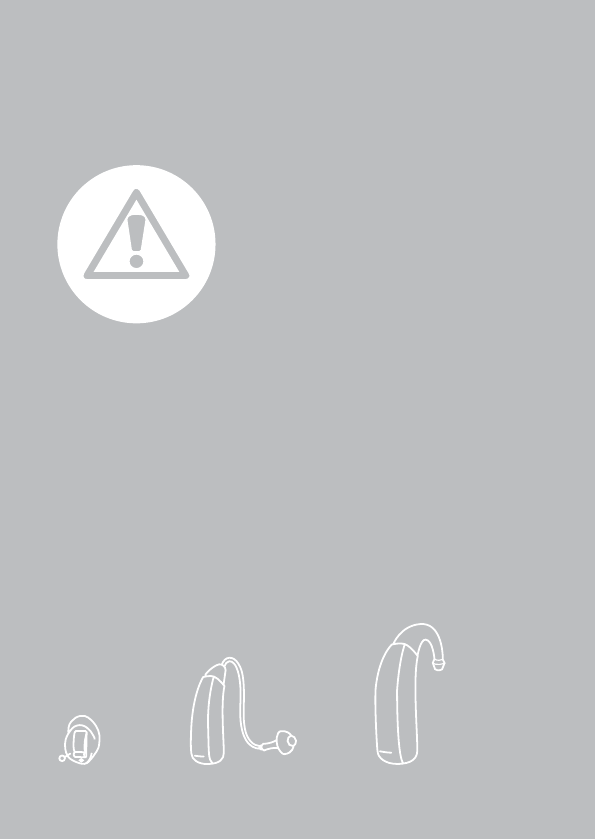
DRAFT 2017-04-11
Safety manual
for hearing instruments
for US and Canadian markets | Master
DRAFT 2017-04-11
2
Content
Safety information 3
Intended use 3
Explanation of symbols 3
General warnings 4
For certain inrument types 12
For children under the age of 3 years 13
For certain battery types 14
When using remote control apps 15
For Hearing Care Professionals 16
Important information 17
Transport and orage conditions 17
Disposal information 18
Conformance information 18
For US and Canadian markets only 21
For prospective hearing inrument users 21
For hearing inrument users 22
Tinnitus feature 30
For children with hearing loss 33
Warranty and service 34
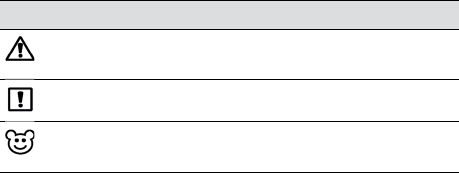
3
DRAFT 2017-04-11
Safety information
This safety manual provides safety information and other
important information about your hearing inruments. It
covers several inrument types and optional features.
XRefer to the user guide of your hearing inruments, to
check the inrument type and the activated features.
Intended use
Hearing inruments are intended to improve the hearing
of hearing impaired persons. Diagnosis and prescription
of a hearing inrument mu be performed by hearing
health specialis, e.g. acouicians, audiologis or
ENT doctors.
Use the hearing inruments and accessories only as
described in the respective user guides.
Explanation of symbols
Symbols used in this document
Points out a situation that could lead to serious,
moderate, or minor injuries.
Indicates possible property damage.
Information and warnings for children with hearing
inruments.
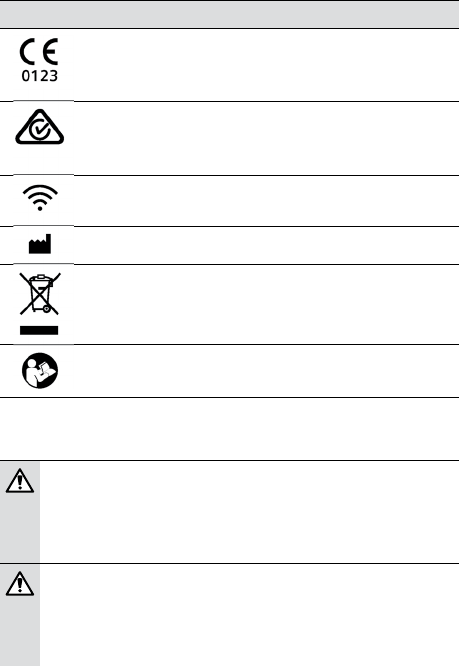
4
DRAFT 2017-04-11
Symbols on the device or packaging
CE compliance label, conrms compliance with
certain European Directives, refer to section
"Conformance information".
EMC and radio communications
compliance label Auralia, refer to section
"Conformance information".
Optional symbol for cuom models with
wireless functionality.
Indicates the legal manufacturer of the device.
Do not dispose of the device with general
domeic wae. Read more in section
"Disposal information".
Read and follow the inructions in the user
guide.
General warnings
WARNING
Risk of impairing the residual hearing of the user.
XUse only hearing inruments that have been
tted especially for your needs.
WARNING
Risk of injury!
XDo not use obviously damaged devices and
return them to point of sale.

5
DRAFT 2017-04-11
WARNING
Note that any unauthorized changes to the product
may cause damage to the product or cause injury.
XUse only approved parts and accessories. Ask
your Hearing Care Professional for support.
WARNING
Your hearing inruments may reduce certain
background sounds, potentially also trac or
warning signals.
WARNING
Risk of explosion!
XDo not use your hearing inruments in explosive
atmospheres (e. g. in mining areas).
WARNING
Choking hazard!
Your hearing inruments contain small parts which
can be swallowed.
XKeep hearing inruments, batteries and
accessories out of reach of children and
mentally disabled persons.
XIf parts have been swallowed consult a physician
or hospital immediately.
If you have hearing inruments that are intended for the
tting of children under the age of 3 years or persons
with a developmental age of under 3 years, refer also to
section "For children under the age of 3 years".

6
DRAFT 2017-04-11
NOTICE
XProtect your hearing inruments from high
humidity. Do not wear them in the shower or
when you apply make-up, perfume, aftershave,
hairspray or suntan lotion.
NOTICE
XProtect your hearing inruments from extreme
heat. Do not expose them to direct sunlight.
NOTICE
XDo not dry your hearing inruments in the
microwave oven.
NOTICE
Dierent types of rong radiation, e. g. during
X-ray or MRI head examinations, may damage
hearing inruments.
XDo not wear the hearing inruments during
these or similar procedures.
Weaker radiation, e. g. from radio equipment or
airport security, does not damage the hearing
inruments.
NOTICE
Your devices comply with international andards.
However, it cannot be guaranteed that all products
on the market work interference-free, for example
some induction cookers may cause audible
interference.

7
DRAFT 2017-04-11
Contraindications
WARNING
Consult a Hearing Care Professional if you
experience any unusual side eects like skin
irritation, excessive accumulation of ear wax,
dizziness, change in your hearing, or if you think
there may be a foreign object in your ear canal.
WARNING
A Hearing Care Professional should advise a
prospective hearing inrument user to consult
a licensed physician before using the hearing
inrument if the Hearing Care Professional
determines that the prospective user has any of the
following conditions:
XVisible congenital or traumatic deformity of the
ear.
XHiory of active drainage from the ear within the
previous 90 days.
XHiory of sudden or rapidly progressive hearing
loss within the previous 90 days.
XAcute or chronic dizziness.
XUnilateral hearing loss of sudden or recent onset
within the previous 90 days.
XAudiometric air-bone gap equal to or greater
than 15 dB at 500 Hz, 1,000 Hz, and 2,000 Hz.
XVisible evidence of signicant cerumen
accumulation or a foreign body in the ear canal.
XPain or discomfort in the ear.

8
DRAFT 2017-04-11
For hearing inruments with wireless functionality
In some countries rerictions for the usage of
wireless equipment exi.
XRefer to local authorities for further information.
WARNING
Risk of aecting electronic equipment!
XIn areas where the use of electronics or wireless
devices are rericted, verify if your device has to
be turned o.
NOTICE
Your hearing inruments are designed to comply
with international andards on electromagnetic
compatibility but interference with nearby electronic
devices could occur. In this case, move away from
the source of interference.

9
DRAFT 2017-04-11
For hearing inruments with a tinnitus feature
Your hearing inrument may be equipped with a tinnitus
feature (e. g. with a tinnitus therapy signal, a tinnitus
noiser, or another special function). The use of the
tinnitus feature should be only on the advice and in
consultation with your Hearing Care Professional.
WARNING
Risk of further impairment to the user’s hearing
health.
The volume of the tinnitus feature can be set to
a level which could lead to permanent hearing
damage when used for a prolonged period of time.
XThe tinnitus feature should never be used at
uncomfortable levels.

10
DRAFT 2017-04-11
For hearing inruments with AutoPhone magnet
WARNING
Risk of aecting life support syems!
XUse a magnet only when it is a safe diance
away from life support syems, such as
pacemakers or magnetic valves. For example,
the safe diance between pacemaker and
magnet should be at lea 10 cm (4 inches).
NOTICE
Magnets can diurb electrical devices and delete
ored data.
XKeep magnets away from computers, monitors,
television sets, orage media and other
electronic equipment/devices.
NOTICE
In close proximity, AutoPhone magnets can
damage receiver units of RIC hearing inruments.
XKeep a minimum diance of 2 cm between the
RIC receiver and any magnet, including the
AutoPhone magnet.
For example, do not ore your RIC hearing
inruments and a smartphone with attached
AutoPhone magnet together in a small pocket
or box.

11
DRAFT 2017-04-11
For hearing inruments with a magnet in the battery
compartment
WARNING
Risk of interference with active and non-active
implants!
If you wear an active or a non-active implant, e.g. a
brain implant:
XPrior to use, have the electromagnetic
compatibility veried.
Consult the physician that implanted the device
before using your hearing inruments.
XKeep a safe diance of about 1.6 inches (4 cm)
between the implant and hearing inruments.
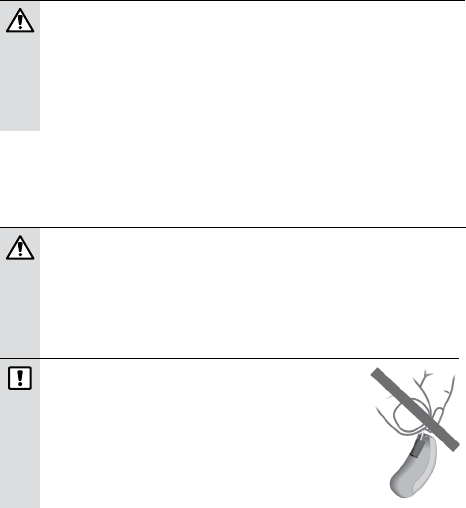
12
DRAFT 2017-04-11
For certain instrument types
BTE models
Inruments that are worn behind the ear and that have a
tube.
CAUTION
Risk of injury!
XAlways wear the tube with an ear piece.
XMake sure that the ear piece is completely
attached.
RIC models
The receiver is placed within the ear canal and connected
to the inrument via a receiver cable.
CAUTION
Risk of injury!
XAlways wear the receiver cable with an ear piece.
XMake sure that the ear piece is completely
attached.
NOTICE
XDo not pull the receiver connection
as this could damage your hearing
inruments.
Other models
For all other models, no model-specic safety information
applies.

13
DRAFT 2017-04-11
For children under the age of 3 years
There are special hearing inruments for the tting
of children under the age of 3 years or persons with a
developmental age of under 3 years. Ask your Hearing
Care Professional for further information.
WARNING
Choking hazard!
Your hearing inruments contain small parts which
can be swallowed.
XEnsure adequate supervision if infants, small
children or mentally disabled persons need to
wear hearing inruments.
XCheck the completeness of the hearing
inruments regularly.
XEnsure that your child or the mentally disabled
person does not detach the hearing inrument
from the earmold.
XConsult your Hearing Care Professional if the
housing is deformed.
XKeep the battery compartment locked. Verify the
proper function of the locking mechanism.
XKeep batteries and accessories out of children's
or mentally disabled person's reach.
XIf swallowed consult a physician or a hospital
immediately.

14
DRAFT 2017-04-11
For certain battery types
For hearing inruments with built-in power cells
(lithium-ion rechargeable batteries)
Read the safety information on power cells in the hearing
inrument's user guide.
For hearing inruments with replaceable batteries
NOTICE
Only use zinc-air batteries or nickel-metal hydride
(NiMH) rechargeable batteries.
Do not use e.g. silver-zinc or lithium-ion
rechargeable batteries.
NOTICE
Leaking batteries damage the hearing inruments.
XTurn the hearing inruments o when not in use
to preserve the battery.
XRemove batteries when the inruments are not
in use for a prolonged period of time.

15
DRAFT 2017-04-11
When using remote control apps
When using an app for controlling hearing inruments:
WARNING
Risk of hearing damage!
The device with the app for controlling hearing
inruments generates short control signals which
may be audible. If the device running the app has
a very high audio output there is the risk of hearing
damage.
While using the app:
XDo not hold the loudspeaker of the device to
your ears or the ears of others.
XDo not use the device with headphones,
headsets or other audio playback devices.

16
DRAFT 2017-04-11
For Hearing Care Professionals
WARNING
For hearing inruments with an output sound
pressure level of 132 dB SPL or more:
Risk of impairing the residual hearing of the user.
XTake special care when tting this inrument.
Tinnitus feature
The target population is primarily the adult population over
21 years of age. The patient may have some control of the
level or volume of the signal and the patient should discuss
this adjument as well as his or her comfort level and
sound of the signal with their Hearing Care Professional.
WARNING
Risk of further impairment to the user’s hearing
health.
The volume of the tinnitus feature can be set to a
level which could lead to permanent hearing damage
when used for a prolonged period of time.
XShould the tinnitus feature be set to such a level
in the hearing inrument, advise the user of
the maximum amount of time per day he or she
should use the tinnitus feature.
For example, occupational safety guidelines
rerict continuous noise exposure of 80 dBA SPL
to 8 hours per day.
XThe tinnitus feature should never be used at
uncomfortable levels.

17
DRAFT 2017-04-11
Important information
Transport and storage conditions
During extended periods of transport and orage, please
observe the following conditions:
For hearing inruments with built-in power cells
(lithium-ion rechargeable batteries)
Read the transport and orage conditions in the hearing
inrument's user guide.
For hearing inruments with replaceable batteries
Storage Transport
Temperature 10 to 40 °C
(50 to 104 °F)
-20 to 60 °C
(-4 to 140 °F)
Relative humidity 10 to 80 % 5 to 90 %
For other parts, such as batteries, other conditions may
apply.
18
DRAFT 2017-04-11
Disposal information
XRecycle hearing inruments, accessories and
packaging according to local regulations.
For hearing inruments with replaceable batteries
XTo avoid environmental pollution, do not throw
batteries into household trash.
XRecycle or dispose of batteries according to local
regulations or return them to your Hearing Care
Professional.
Conformance information
The CE mark indicates conformity with the following
European directives:
■ 93/42/EEC concerning medical devices
■ Only for products with wireless functionality:
99/5/EC R&TTE concerning radio and
telecommunications equipment (valid until
June 12th, 2016) or 2014/53/EU RED concerning radio
equipment (valid from June 13th, 2016)
■ 2011/65/EU RoHS concerning the reriction of
hazardous subances
The full text of the declaration of conformity can
be obtained from www.signia-hearing.com/doc (for
hearing inruments manufactured by Signia GmbH) or
from www.sivantos.com/doc (for hearing inruments
manufactured by Sivantos GmbH).

19
DRAFT 2017-04-11
The ACMA compliance mark indicates conformity
with the electromagnetic interference andards set by
the Auralian Communications and Media Authority
(ACMA).
Devices with the FCC marking comply with the andards
of the FCC regarding electromagnetic interference (only
for products with wireless functionality).
Technical details
If the certication information for USA and Canada is not
lied in the hearing inruments' user guide, the following
certication numbers apply:
■ Wireless platform, model: e2e 3.0
■ USA FCC ID: SGI-WL003BTE
■ Canada: 267AB-WL003BTE
Notices
This Class B digital apparatus complies with Canadian
ICES-003.
Changes or modications made to this equipment not
expressly approved by the legal manufacturer may void
the FCC authorization to operate this equipment.
This device complies with Part 15 of the FCC Rules and
with Canada's RSS-210 ISED’s licence-exempt RSSs.
20
DRAFT 2017-04-11
Operation is subject to the following conditions:
■ this device may not cause harmful interference, and
■ this device mu accept any interference received,
including interference that may cause undesired
operation.
This equipment has been teed and found to comply
with the limits for a Class B digital device, pursuant to
Part 15 of the FCC Rules. These limits are designed
to provide reasonable protection again harmful
interference in a residential inallation. This equipment
generates, uses and can radiate radio frequency energy
and, if not inalled and used in accordance with the
inructions, may cause harmful interference to radio
communications. However, there is no guarantee that
interference will not occur in a particular inallation. If
this equipment does cause harmful interference to radio
or television reception, which can be determined by
turning the equipment o and on, the user is encouraged
to try to correct the interference by one or more of the
following measures:
■ Reorient or relocate the receiving antenna.
■ Increase the separation between the equipment and
receiver.
■ Connect the equipment to an outlet on a circuit
dierent from that to which the receiver is connected.
■ Consult the dealer or an experienced radio/TV
technician for help.
21
DRAFT 2017-04-11
For body worn operation, this device has been teed
and meets the FCC RF exposure guidelines when used
with the legal manufacturer’s accessories supplied or
designated for this product. Use of other accessories may
not ensure compliance with FCC RF exposure guidelines.
22
DRAFT 2017-04-11
For US and Canadian markets only
For prospective hearing instrument users
Good health practice requires that a person with a hearing
loss have a medical evaluation by a licensed physician
(preferably a physician who specializes in diseases
of the ear) before purchasing a hearing inrument.
Licensed physicians who specialize in diseases of the ear
are often referred to as otolaryngologis, otologis or
otorhinolaryngologis. The purpose of medical evaluation
is to assure that all medically treatable conditions that may
aect hearing are identied and treated before the hearing
inrument is purchased.
Following the medical evaluation, the physician will give
you a written atement that ates that your hearing
loss has been medically evaluated and that you may
be considered a candidate for hearing inruments. The
physician will refer you to a Hearing Care Professional for
a hearing inrument evaluation.
The Hearing Care Professional will conduct a hearing
inrument evaluation to assess your ability to hear with
and without hearing inruments. The hearing inrument
evaluation will enable the Hearing Care Professional to
select and t hearing inruments to your individual needs.
If you have reservations about your ability to adapt to
amplication, you should inquire about the availability of
23
DRAFT 2017-04-11
a trial-rental or purchase-option program. Many Hearing
Care Professionals now oer programs that permit you
to wear hearing inruments for a period of time for a
nominal fee after which you may decide if you want to
purchase them.
U.S. federal law rericts the sale of hearing inruments
to those individuals who have obtained a medical
evaluation from a licensed physician. U.S. federal law
permits a fully informed adult to sign a waiver atement
declining the medical evaluation for religious or personal
beliefs that preclude consultation with a physician. The
exercise of such a waiver is not in your be health
intere and its use is rongly discouraged.
For hearing instrument users
Hearing inruments will not reore normal hearing and
will not prevent or improve a hearing impairment resulting
from organic conditions. In mo cases infrequent use of
hearing inruments prohibits the wearer from attaining
the full benet from it. The use of hearing inruments is
only part of hearing rehabilitation and may need to be
supplemented by auditory training and inruction in lip
reading.
Health considerations
If soreness or skin irritation develops, discontinue
wearing your hearing inruments, and bring the
inruments and earmolds to your Hearing Care
24
DRAFT 2017-04-11
Professional. Minor t adjuments or earmold
modication can often correct this condition. If soreness
persis, discontinue wearing the hearing inrument and
see your physician. If excessive earwax accumulates
when wearing your hearing inruments, consult your
Hearing Care Professional.
Battery tips
If a battery is accidentially swallowed, seek medical
attention immediately, or call the National Battery Hotline
collect at (202) 625-3333.
Identication information
Your hearing inruments have a serial number imprinted
on them. The location of the serial number will vary
according to the yle of hearing inrument you have
chosen. Record the serial number in your user guide for
future reference.
The year of manufacture is incorporated into the serial
number.
For cuom inruments, the year of manufacture
is derived from the r two digits. In the following
examples, the year of manufacture is 2016.
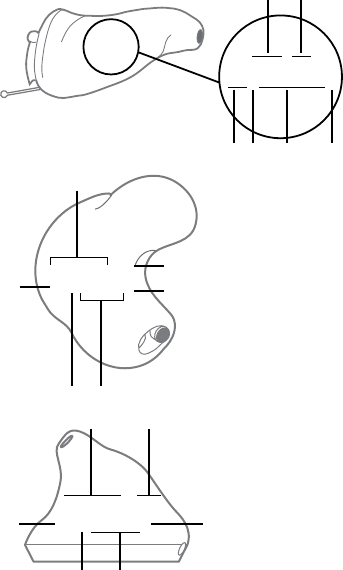
25
DRAFT 2017-04-11
16X0123456R
xxxx /
xxxx/xx
16X0123456R
xx
➊➋ ➌ ➍
➎ ➏
XXXXX/XXX
16X123456R
➊
➋ ➌
➍
➎
➏
➊ 16:
year manufactured
➋ X:
facility code where
inrument was
manufactured
➌ Serial number
➍ L or R:
left or right ear inrument
➎ Manufacturer/Diributor
➏ Model
XXXXX XX
16X123456R
➊
➋ ➌
➍
➎ ➏
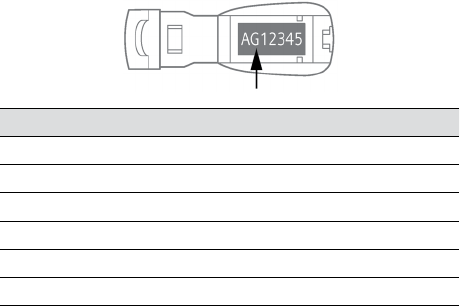
26
DRAFT 2017-04-11
For BTE and RIC inruments, the year of manufacture is
derived from the second digit:
Code (second digit) Year
D, E, F 2013
G, H 2014
L, M 2015
N, P 2016
Q, R 2017
S, T 2018
Please note the warranty is based upon the date of
purchase, not the date of manufacture.
Your Audiologi or Hearing Care Professional can
answer any queions you may have about the identifying
code on your hearing inrument.

27
DRAFT 2017-04-11
Wireless functionality
The following tables summarizes the technical details of
the wireless technology:
Wireless technology Neareld magnetic induction
Antenna type Inductive antenna
Antenna dimensions BTE or RIC models:
Ø: 1.9 mm, L: 6.5 mm, respectively,
Ø: 2.3 mm, L: 5.7 mm, respectively,
Ø: 2.8 mm, L: 4.4 mm
Cuom models:
Ø: 3.3 mm, L: 4.2 mm, respectively,
Ø: 2.0 mm, L: 6.7 mm
Modulation PSK (Phase Shift Key)
Magnetic eld
rength
0.07 A/m, (1 cm2 coil; average)
Output power (EIRP) 53 μW
EIRP = Equivalent isotropically radiated power
Range < 20 cm between hearing inruments
Center frequency 3.28 MHz
Channel Single channel radio
Bandwidth BTE or RIC models: 140 kHz
Cuom models: 138 kHz
Data rate 324 kbit/sec (raw channel capacity)
Data ow Simplex or semi-duplex capability

28
DRAFT 2017-04-11
Protocol Random access, no collision
avoidance
S.A.R. 2.36 nW/kg (BTE)
6.63 nW/kg (cuom models)
S.A.R. = Specic Absorption Rate (S.A.R.) based on
10 g ICNIRP teing.
Bluetooth® low energy*
Wireless technology Radio frequency -
Bluetooth low energy
Antenna type Electromagnetic dipole antenna
Antenna dimensions BTE or RIC models:
H: approx. 4 mm, L: approx. 15 mm
Magnetic eld
rength
not applicable
Output power (EIRP) 150 μW
EIRP = Equivalent isotropically radiated power
Range < 10 m between smartphone/
accessory and hearing inruments
Center frequency 2.45 GHz
Channel 40 channel radio
Bandwidth 2 MHz per channel
* The Bluetooth word mark and logos are owned by the Bluetooth SIG, Inc., and any
use of such marks by the legal manufacturer of this product is under licenses. Other
trademarks and trade names are those of their respective owners.

29
DRAFT 2017-04-11
Data rate 1 Mbit/sec, respectively, 2 Mbit/sec
Data ow Simplex or semi-duplex capability
Protocol Bluetooth network FHSS (Frequency
Hopping Spread Spectrum)
S.A.R. 1.31 nW/kg
S.A.R. = Specic Absorption Rate (S.A.R.) based on
10 g ICNIRP teing.
EMI/EMC compliance
Wireless hearing inruments comply with the following
EMC/EMI andards:
Standard Te Type Note
47 CFR Part 15,
Subpart C
RF emissions U.S. FCC requirements
for intentional radiators.
EN 300 330-1/2 RF emissions
including
spurious
emission
EMC and radio
spectrum matters for
short range devices in
the frequency range
9 kHz - 25 MHz.
EN 301 489-1/3 Immunity,
RF and ESD
Standard for low
power transmitters in
the frequency range
9 kHz - 40 GHz.

30
DRAFT 2017-04-11
Standard Te Type Note
EN 300 328 Signal integrity
and emissions
Wideband transmission
syems; data
transmission equipment
operating in the 2.4 GHz
ISM band and using
wide band modulation
techniques
IEC 60118-13 RF immunity International product
andard for hearing
inruments to ensure
adequate immunity to
radio interference from
mobile telephones.
ANSI C63.19 RF immunity American National
Standard method
of measurement of
compatibility between
wireless communication
devices and hearing
inruments.
ANSI/AAMI
PC69
RF emissions Implantable medical
device EMC immunity.
ISO 14117 RF emissions Implantable medical
device EMC immunity.
EN 45502-2-1 RF emissions Particular requirements
for pacemakers.
31
DRAFT 2017-04-11
Wireless security measures
Wireless signal security is assured through the device
syem design that includes:
■ A built-in pairing table which species valid and
legitimate pairing among units.
■ A proprietary communication protocol which checks
the package numbers during each transmission.
■ A Cyclic Redundancy Check (CRC) to check data
validity.
■ A convolutional encoder/decoder (Viterbi) to correct
errors.
The Bluetooth low energy connection uses the security
measures that are dened in the Bluetooth low energy
andard.
Tinnitus feature
Your hearing inrument may be equipped with a tinnitus
feature. Many tinnitus patients also suer from some
degree of hearing loss. Many hearing inruments can
be used alone or in combination with the tinnitus feature.
The tinnitus feature is xed to a broadband noise that can
be adjued by your Hearing Care Professional for your
tinnitus therapy.
The feature may provide temporary relief of your tinnitus.
32
DRAFT 2017-04-11
Prescription Use Only
U.S. federal law rericts this device to sale by or on the
order of a doctor or Hearing Care Professional licensed
to dispense hearing inruments in your ate. The use of
any sound generating tinnitus therapy device should be
only on the advice and in consultation with your Hearing
Care Professional. Your Hearing Care Professional will
properly diagnose and t the device to your personal
needs and requirements. This should include its use in a
prescribed tinnitus treatment program. Your Hearing Care
Professional will also be able to oer the appropriate
follow-up care. It is important that you follow your Hearing
Care Professional’s advice and direction regarding such
care.
There are some potential concerns associated with the
use of any sound generating tinnitus therapy device.
Discontinue use and seek medical evaluation if any of the
following conditions occur:
■ Chronic skin irritation on, near, or around the site of
device placement.
■ Unusual side eects (e.g., dizziness, nausea,
headaches, heart palpitations).
■ Perceived decrease in auditory function
(e.g., decreased loudness, speech not as clear).
33
DRAFT 2017-04-11
For Hearing Care Professionals
Indications for use
The tinnitus feature is a tool to generate sounds to be
used in a tinnitus management program to relieve patients
suering from tinnitus. The target population is primarily
the adult population over 21 years of age. The tinnitus
feature is targeted for healthcare professionals treating
patients suering from tinnitus, as well as conventional
hearing disorders. The tting of the tinnitus feature should
be done by a Hearing Care Professional participating in a
tinnitus management program.
Device description
The tinnitus feature is a software function that generates
sound which is programmed into a hearing inrument.
Depending on the type of hearing inrument, the hearing
inrument may be used in up to three modes of operation:
as a hearing inrument, as a tinnitus treatment device, or
as a hearing inrument and tinnitus treatment device.
When enabled, the tinnitus feature generates the sound
and allows a patient’s Hearing Care Professional to design
and program appropriate settings for an individually
prescribed sound treatment plan. The treatment plan
should be used in a tinnitus management program for
relief of tinnitus.
The tinnitus feature generates a broadband noise
signal that varies in frequency and amplitude. These
characteriics are adjuable by the Hearing Care
34
DRAFT 2017-04-11
Professional and are specic to the prescribed therapy
designed by the professional for the patient’s needs and
comfort. The patient may have some control of the level
or volume of the signal and the patient should discuss
this adjument as well as his or her comfort level and
sound of the signal with their Hearing Care Professional.
A Hearing Care Professional should advise a prospective
tinnitus feature user to consult promptly with a licensed
physician (preferably an ear speciali) before using
the tinnitus feature if the Hearing Care Professional
determines through inquiry, actual observation, or
review or any other available information concerning the
prospective user that the prospective user has any of the
following conditions:
■ Visible congenital or traumatic deformity of the ear.
■ Hiory of active drainage from the ear within the
previous 90 days.
■ Hiory of sudden or rapidly progressive hearing loss
within the previous 90 days.
■ Acute or chronic dizziness.
■ Unilateral hearing loss of sudden or recent onset
within the previous 90 days.
For children with hearing loss
In addition to seeing a physician for a medical evaluation,
a child with a hearing loss should be directed to an
audiologi for evaluation and rehabilitation since hearing
35
DRAFT 2017-04-11
loss may cause problems in language development
and the educational and social growth of a child. An
audiologi is qualied by training and experience to
assi in the evaluation and rehabilitation of a child with a
hearing loss.
Warranty and service
Your hearing inrument, with the exception of the
battery, is covered by a comprehensive warranty. All
covered inrument parts received for warranty service at
an authorized service center will be repaired or replaced
with new or reconditioned components, without charge, to
meet the performance specications for that model.
This warranty does not cover malfunctions due to
unusual wear and tear or mireatment of the inrument
such as physical shock, excessive wax build-up, or
tampering with the inrument, any of which voids all
warranties. Your Hearing Care Professional may charge
a service fee for processing warranty service.
Warranty service mu only be performed by an
authorized service center. Service performed by
unauthorized service depots voids this warranty, and
repairs so necessitated will be done on a parts and labor
co basis.
Please refer to the warranty card included with your
hearing inruments for warranty period eective dates.
36
DRAFT 2017-04-11
Your hearing inruments may have additional loss and
damage coverage. Please consult your Hearing Care
Professional to determine if this is applicable to your
hearing inruments.
Risk mitigations (for internal use only)
IFU101 | interference induction cooker | device ...................................6
M11 | explosion | HI ..............................................................................5
M15 | choking | non-ped HI ..................................................................5
M18_2/2 | Battery type ........................................................................14
M20_1/4 | heat | HI ...............................................................................6
M20_2/4 | humidity | HI not Aquaris ......................................................6
M20_3/4 | microwave | HI .....................................................................6
M20_4/4 | X-Ray | HI ............................................................................6
M23 | wireless interference ...................................................................8
M28, M213 | environmental pollution ..................................................18
M29 | recycle HI ..................................................................................18
M31_1/3 | tube with ear piece .............................................................12
M35 | choking | pediatric .....................................................................13
M38_1/2 | autophone | interference ....................................................10
M38_2/2 | autophone | life support .....................................................10
M48_1/3 | cable with ear piece ...........................................................12
M78a | more than 132 dB ...................................................................16
M90 | only tted | HI ..............................................................................4
M91 | interference .................................................................................8
M102 | magnet in HI ...........................................................................11
M105_2/2 | tinnitus D8 und D9 .............................................................9
M106_1/2 | tinnitus dispenser .............................................................16
M107 | directionality ..............................................................................5
M108 | app acouic control signal .....................................................15
M109 | damaged device | HI .................................................................4
M110 | unauthorized modications .......................................................5
M111 | contraindications dispenser (replaces M106_2/2) ab RA V29 . . 7
M112 | contraindications user (replaces M105_1/2) ab D9 ..................7

Document No. 02421-99T##-#### ##
Order/Item No. ### ### ##
Master Rev08, 04.2017
© Sivantos GmbH, ##.2017 0123
This document applies to hearing instruments manufactured by
Sivantos GmbH and by Signia GmbH.